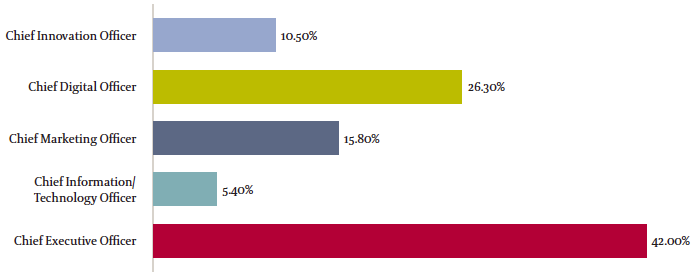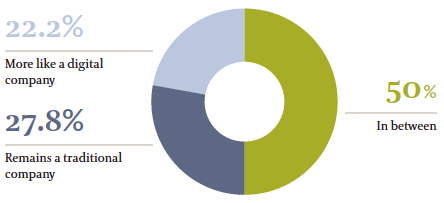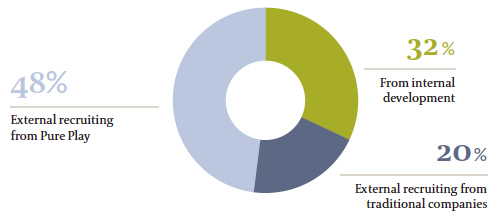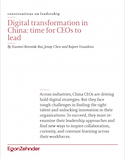Across industries, China CEOs are driving bold digital strategies. But they face tough challenges in finding the right talent and unlocking innovation in their organizations. To succeed, they must reexamine their leadership approaches and find new ways to inspire collaboration, curiosity, and constant learning across their workforces.
Digital disruption is sweeping the world, and its center of gravity is fast shifting to China. Alibaba holds the world record for the largest opening-day IPO, and WeChat achieved more mobile transactions over Chinese New Year than PayPal did in an entire year. Venture capital investment in China-based internet businesses now outstrips that in the United States by a significant margin.1
While China’s big technology players have grabbed the headlines, companies in many other industries – from consumer goods to financial services – are harnessing digital to reimagine their business models, processes, and customer experience.
These companies are driving bold digital strategies, typically led by the China CEO, but they face tough challenges in finding and integrating digital talent and transforming their organizations and culture to unlock speed and innovation. For the CEO and other senior executives, the challenge is personal: they must often re-examine leadership approaches developed over a lifetime, and find new ways to inspire collaboration, curiosity, and constant learning across their workforces.
These challenges prompted Egon Zehnder to invite China CEOs and other senior leaders to convene in Shanghai in late 2016 to debate the topic of “unlocking leadership potential for digital transformation”. More than 20 major companies operating in China were represented at the event. They were joined by Rajeev Vasudeva, the CEO of Egon Zehnder. The event was chaired by Xuemei Bennink-Bai, leader of Egon Zehnder’s Consumer and Human Resources Practices in Greater China.
1 See “The rise of China’s silicon dragon”, PwC, May 2016
Digital is a top priority for most China CEOs – but implementation is a work in progress
Among companies represented at the event, digital is clearly a major strategic priority. Nearly 70% of participants said their board or headquarters was sponsoring digital, and nearly half said their CEO was the primary champion of their digital efforts (Exhibit 1). Companies were much more likely to see themselves as leading the digital disruption than being threatened by it – and reported that they were harnessing digital to shape new business models and better customer experience.
Leadership
Who is the primary champion of digital in your organisation?

Exhibit 1
Source: Egon Zehnder survey of China CEOs and executives, November 2016
The leaders at our event agreed strongly that digital is no fad, and that it will drive dramatic change across their organizations. Egon Zehnder’s Rajeev Vasudeva summed it up:
“Digital is not about just launching a new business activity or a new business model. It’s a complete transformation of all you do, and it impacts every part of the organization. It’s about how you approach the market, how you respond to customers, how you provide more customization, and how you integrate this with the back office and the supply chain. It’s really a different way of thinking.”
But participants acknowledged that their companies still have a lot to do if they are to embed this new way of thinking in their organizations – and translate their bold strategic visions into reality. Most of them said their company was currently “in between” a traditional and a digital company, and many said their organization model for digital was still under development (Exhibit 2).
Organization/Culture
How would you describe your current company culture with regard to digital?

Exhibit 2
Source: Egon Zehnder survey of China CEOs and executives, November 2016
Demand for digital talent outstrips supply, so companies should focus on potential
As a core part of their digital transformations, companies are engaged in an aggressive drive to hire digital talent from outside their organizations, and are also seeking to nurture digital talent from within their ranks. But it is proving a challenge to strike the right balance between external hires and internal development, as discussion at the event made clear. Most companies represented said that external recruiting from pure-play tech firms was their main source of digital talent, and only 32% said they looked to internal development for digital talent (Exhibit 3).
Talent
Where are your digital people from?

Exhibit 3
Source: Egon Zehnder survey of China CEOs and executives, November 2016
But several speakers emphasized that retaining and integrating talent from pure-play tech firms in incumbent companies is difficult, making overreliance on external recruiting a risk. Participating executives admitted that they struggle to integrate and retain external talent, and cited it as their single biggest issue related to digital talent.
Rajeev Vasudeva noted that there is huge demand for people with pure-play tech company experience, and that 90% of such digital talent are actively looking for their next job. That, he said, makes it imperative that companies make a special effort to engage their digital talent – including by building a culture of collaborative decision-making, and giving digital talent greater autonomy, more resources, and access and visibility to senior leaders both globally and in China.
Equally important, companies assessing digital talent should look beyond the candidates’ experience and put much more weight on understanding their potential – because they are looking for people to succeed in an area that is still largely unchartered. Specifically, companies should look for candidates who exhibit a high degree of curiosity and insight – two key markers of leadership potential.2 Greater emphasis on potential opens up new opportunities to seek out internal talent to lead digital efforts. With the right development, people who currently occupy operational roles in non-digital areas can grow into highly successful digital leaders.
2 See “Winning the War for Digital Talent in China”, Egon Zehnder, 2016
Digital transformation starts at the top: the critical role of the China CEO
One anecdote shared by a panelist at the event highlighted the critical role that CEO’s and senior leaders must play in digital transformation – and the distance that many still have to go in embracing a new way of thinking. The panelist recounted a key presentation by their company’s digital strategy team, which was distributed to top leaders in electronic format. But several of them asked for paper copies – contradicting the company’s drive to embrace digital channels.
Recognizing the need for leaders to reexamine their own mindsets, some companies are creating immersion experiences to expose senior executives to the practices of the digital pioneers. For example, one China-based multinational sent its top 30 executives to Silicon Valley to engage with their counterparts at companies such as Facebook, Google, and Uber – so bringing them closer to the forefront of global digital transformation. Likewise, one China CEO brought their global CEO and executive team to visit pure-play digital companies in China, including Tencent and Alibaba.
As digital champion, the China CEO needs to engage the entire organization – both global and regional stakeholders and the China team on the ground – around the shift to digital. One core task for the CEO and other senior leaders is to build and role-model a faster-moving, less hierarchical, and more innovative culture in their company. They can encourage internal entrepreneurship; flatten organization structures; make greater use of digital channels for internal communication; and champion initiatives that train employees to become more digitally-minded.
The China CEO and senior leaders also need to engage their stakeholders and prepare their teams for constant change and a large dose of ambiguity. For example, there is still much debate on the right organizational home for digital in an incumbent organization – a centralized function, a separate business, or part of an existing function such as Marketing (Exhibit 4). Leaders must be ready to act fast in making organizational changes, and ready to rethink those changes as the digital transformation evolves – while keeping teams informed and engaged.
Last but not least, the China CEO also has a key role in nurturing talent needed for successful digital transformation. He or she should see themselves as the guardian of digital talent in the organization – investing time in personally motivating such talent, and protecting them from traditional processes or mindsets when necessary.
Organization/Culture
Where does digital sit in your organization?

Exhibit 4
Source: Egon Zehnder survey of China CEOs and executives, November 2016
The digital transformation is unstoppable. It is creating exciting opportunities for incumbent companies to reinvent their business models, customer experience, and internal processes – and unlock huge value as a result. But these efforts will only succeed if companies can find and engage the digital talent who can take innovation to new levels. That calls for personal leadership by China CEO’s – to champion a culture of speed and collaboration, to nurture and protect digital talent, and to role-model a new way of thinking.






